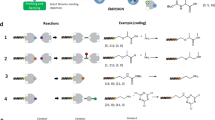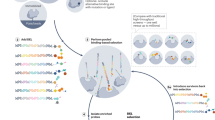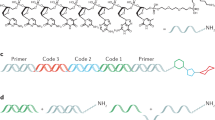Abstract
DNA-encoded chemical libraries (DECLs) are collections of organic compounds that are individually linked to different oligonucleotides, serving as amplifiable identification barcodes. As all compounds in the library can be identified by their DNA tags, they can be mixed and used in affinity-capture experiments on target proteins of interest. In this protocol, we describe the screening process that allows the identification of the few binding molecules within the multiplicity of library members. First, the automated affinity selection process physically isolates binding library members. Second, the DNA codes of the isolated binders are PCR-amplified and subjected to high-throughput DNA sequencing. Third, the obtained sequencing data are evaluated using a C++ program and the results are displayed using MATLAB software. The resulting selection fingerprints facilitate the discrimination of binding from nonbinding library members. The described procedures allow the identification of small organic ligands to biological targets from a DECL within 10 d.
This is a preview of subscription content, access via your institution
Access options
Subscribe to this journal
Receive 12 print issues and online access
$259.00 per year
only $21.58 per issue
Buy this article
- Purchase on Springer Link
- Instant access to full article PDF
Prices may be subject to local taxes which are calculated during checkout






Similar content being viewed by others
Change history
01 April 2016
In the version of this article initially published online, two of the reference citations were to the wrong references. In addition, incorrect units were given for the final concentration of PBST-biotin. The errors have been corrected for all versions of this article.
References
Mayr, L.M. & Bojanic, D. Novel trends in high-throughput screening. Curr. Opin. Pharmacol. 9, 580–588 (2009).
Wigglesworth, M.J., Murray, D.C., Blackett, C.J., Kossenjans, M. & Nissink, J.W. Increasing the delivery of next generation therapeutics from high-throughput screening libraries. Curr. Opin. Chem. Biol. 26, 104–110 (2015).
Macarron, R. et al. Impact of high-throughput screening in biomedical research. Nat. Rev. Drug Discov. 10, 188–195 (2011).
Zhang, J., Yang, P.L. & Gray, N.S. Targeting cancer with small-molecule kinase inhibitors. Nat. Rev. Cancer 9, 28–39 (2009).
Shuker, S.B., Hajduk, P.J., Meadows, R.P. & Fesik, S.W. Discovering high-affinity ligands for proteins: SAR by NMR. Science 274, 1531–1534 (1996).
Rees, D.C., Congreve, M., Murray, C.W. & Carr, R. Fragment-based lead discovery. Nat. Rev. Drug Discov. 3, 660–672 (2004).
Jorgensen, W.L. The many roles of computation in drug discovery. Science 303, 1813–1818 (2004).
Reker, D. et al. Revealing the macromolecular targets of complex natural products. Nat. Chem. 6, 1072–1078 (2014).
Reker, D. & Schneider, G. Active-learning strategies in computer-assisted drug discovery. Drug Discov. Today 20, 458–465 (2015).
Mannocci, L., Leimbacher, M., Wichert, M., Scheuermann, J. & Neri, D. 20 years of DNA-encoded chemical libraries. Chem. Commun. 47, 12747–12753 (2011).
Kleiner, R.E., Dumelin, C.E. & Liu, D.R. Small-molecule discovery from DNA-encoded chemical libraries. Chem. Soc. Rev. 40, 5707–5717 (2011).
Franzini, R.M., Neri, D. & Scheuermann, J. DNA-encoded chemical libraries: advancing beyond conventional small-molecule libraries. Acc. Chem. Res. 47, 1247–1255 (2014).
Brenner, S. & Lerner, R.A. Encoded combinatorial chemistry. Proc. Natl. Acad. Sci. USA 89, 5381–5383 (1992).
Needels, M.C. et al. Generation and screening of an oligonucleotide-encoded synthetic peptide library. Proc. Natl. Acad. Sci. USA 90, 10700–10704 (1993).
Buller, F. et al. Discovery of TNF inhibitors from a DNA-encoded chemical library based on Diels-Alder cycloaddition. Chem. Biol. 16, 1075–1086 (2009).
Leimbacher, M. et al. Discovery of small-molecule interleukin-2 inhibitors from a DNA-encoded chemical library. Chemistry 18, 7729–7737 (2012).
Buller, F. et al. Selection of carbonic anhydrase IX inhibitors from one million DNA-encoded compounds. ACS Chem. Biol. 6, 336–344 (2011).
Clark, M.A. et al. Design, synthesis and selection of DNA-encoded small-molecule libraries. Nat. Chem. Biol. 5, 647–654 (2009).
Franzini, R.M., Nauer, A., Scheuermann, J. & Neri, D. Interrogating target-specificity by parallel screening of a DNA-encoded chemical library against closely related proteins. Chem. Commun. 51, 8014–8016 (2015).
Franzini, R.M. et al. Identification of structure-activity relationships from screening a structurally compact DNA-encoded chemical library. Angew. Chem. Int. Ed. Engl. 54, 3927–3931 (2015).
Samain, F. et al. Tankyrase 1 inhibitors with drug-like properties identified by screening a DNA-encoded chemical library. J. Med. Chem. 58, 5143–5149 (2015).
Buller, F. et al. Design and synthesis of a novel DNA-encoded chemical library using Diels-Alder cycloadditions. Bioorg. Med. Chem. Lett. 18, 5926–5931 (2008).
Gartner, Z.J. et al. DNA-templated organic synthesis and selection of a library of macrocycles. Science 305, 1601–1605 (2004).
Kleiner, R.E., Dumelin, C.E., Tiu, G.C., Sakurai, K. & Liu, D.R. In vitro selection of a DNA-templated small-molecule library reveals a class of macrocyclic kinase inhibitors. J. Am. Chem. Soc. 132, 11779–11791 (2010).
Georghiou, G., Kleiner, R.E., Pulkoski-Gross, M., Liu, D.R. & Seeliger, M.A. Highly specific, bisubstrate-competitive Src inhibitors from DNA-templated macrocycles. Nat. Chem. Biol. 8, 366–374 (2012).
Maianti, J.P. et al. Anti-diabetic activity of insulin-degrading enzyme inhibitors mediated by multiple hormones. Nature 511, 94–98 (2014).
Tse, B.N., Snyder, T.M., Shen, Y. & Liu, D.R. Translation of DNA into a library of 13,000 synthetic small-molecule macrocycles suitable for in vitro selection. J. Am. Chem. Soc. 130, 15611–15626 (2008).
Li, Y., Zhao, P., Zhang, M., Zhao, X. & Li, X. Multistep DNA-templated synthesis using a universal template. J. Am. Chem. Soc. 135, 17727–17730 (2013).
Blakskjaer, P., Heitner, T. & Hansen, N.J. Fidelity by design: Yoctoreactor and binder trap enrichment for small-molecule DNA-encoded libraries and drug discovery. Curr. Opin. Chem. Biol. 26, 62–71 (2015).
Weisinger, R.M., Wrenn, S.J. & Harbury, P.B. Highly parallel translation of DNA sequences into small molecules. PLoS ONE 7, e28056 (2012).
Melkko, S., Scheuermann, J., Dumelin, C.E. & Neri, D. Encoded self-assembling chemical libraries. Nat. Biotechnol. 22, 568–574 (2004).
Wichert, M. et al. Dual-display of small molecules enables the discovery of ligand pairs and facilitates affinity maturation. Nat. Chem. 7, 241–249 (2015).
Zambaldo, C., Barluenga, S. & Winssinger, N. PNA-encoded chemical libraries. Curr. Opin. Chem. Biol. 26, 8–15 (2015).
Eberhard, H., Diezmann, F. & Seitz, O. DNA as a molecular ruler: interrogation of a tandem SH2 domain with self-assembled, bivalent DNA-peptide complexes. Angew. Chem. Int. Ed. Engl. 50, 4146–4150 (2011).
Winssinger, N. et al. PNA-encoded protease substrate microarrays. Chem. Biol. 11, 1351–1360 (2004).
Ciobanu, M. et al. Selection of a synthetic glycan oligomer from a library of DNA-templated fragments against DC-SIGN and inhibition of HIV gp120 binding to dendritic cells. Chem. Commun. 47, 9321–9323 (2011).
Gorska, K., Huang, K.T., Chaloin, O. & Winssinger, N. DNA-templated homo- and heterodimerization of peptide nucleic acid encoded oligosaccharides that mimick the carbohydrate epitope of HIV. Angew. Chem. Int. Ed. Engl. 48, 7695–7700 (2009).
Daguer, J.P. et al. DNA display of fragment pairs as a tool for the discovery of novel biologically active small molecules. Chem. Sci. 6, 739–744 (2015).
Novoa, A., Machida, T., Barluenga, S., Imberty, A. & Winssinger, N. PNA-encoded synthesis (PES) of a 10,000-member hetero-glycoconjugate library and microarray analysis of diverse lectins. ChemBioChem 15, 2058–2065 (2014).
Litovchick, A. et al. Encoded library synthesis using chemical ligation and the discovery of sEH inhibitors from a 334-million member library. Sci. Rep. 5, 10916 (2015).
Franzini, R.M. et al. Systematic evaluation and optimization of modification reactions of oligonucleotides with amines and carboxylic acids for the synthesis of DNA-encoded chemical libraries. Bioconjug. Chem. 25, 1453–1461 (2014).
Satz, A.L. et al. DNA compatible multistep synthesis and applications to DNA encoded libraries. Bioconjug. Chem. 26, 1623–1632 (2015).
Smith, G.P. Filamentous fusion phage: novel expression vectors that display cloned antigens on the virion surface. Science 228, 1315–1317 (1985).
McCafferty, J., Griffiths, A.D., Winter, G. & Chiswell, D.J. Phage antibodies: filamentous phage displaying antibody variable domains. Nature 348, 552–554 (1990).
Kang, A.S., Barbas, C.F., Janda, K.D., Benkovic, S.J. & Lerner, R.A. Linkage of recognition and replication functions by assembling combinatorial antibody Fab libraries along phage surfaces. Proc. Natl. Acad. Sci. USA 88, 4363–4366 (1991).
Liang, P. & Pardee, A.B. Differential display of eukaryotic messenger RNA by means of the polymerase chain reaction. Science 257, 967–971 (1992).
Josephson, K., Ricardo, A. & Szostak, J.W. mRNA display: from basic principles to macrocycle drug discovery. Drug Discov. Today 19, 388–399 (2014).
Hanes, J. & Pluckthun, A. In vitro selection and evolution of functional proteins by using ribosome display. Proc. Natl. Acad. Sci. USA 94, 4937–4942 (1997).
Boder, E.T. & Wittrup, K.D. Yeast surface display for screening combinatorial polypeptide libraries. Nat. Biotechnol. 15, 553–557 (1997).
Ellington, A.D. & Szostak, J.W. In vitro selection of RNA molecules that bind specific ligands. Nature 346, 818–822 (1990).
Tuerk, C. & Gold, L. Systematic evolution of ligands by exponential enrichment: RNA ligands to bacteriophage T4 DNA polymerase. Science 249, 505–510 (1990).
Lipinski, C.A., Lombardo, F., Dominy, B.W. & Feeney, P.J. Experimental and computational approaches to estimate solubility and permeability in drug discovery and development settings. Adv. Drug Deliv. Rev. 46, 3–26 (2001).
Griffiths, A.D. et al. Isolation of high-affinity human antibodies directly from large synthetic repertoires. EMBO J. 13, 3245–3260 (1994).
Franzini, R.M. et al. 'Cap-and-Catch' purification for enhancing the quality of libraries of DNA conjugates. ACS Comb. Sci. 17, 393–398 (2015).
Margulies, M. et al. Genome sequencing in microfabricated high-density picolitre reactors. Nature 437, 376–380 (2005).
Bentley, D.R. et al. Accurate whole-human-genome sequencing using reversible terminator chemistry. Nature 456, 53–59 (2008).
Mannocci, L. et al. High-throughput sequencing allows the identification of binding molecules isolated from DNA-encoded chemical libraries. Proc. Natl. Acad. Sci. USA 105, 17670–17675 (2008).
Buller, F. et al. High-throughput sequencing for the identification of binding molecules from DNA-encoded chemical libraries. Bioorg. Med. Chem. Lett. 20, 4188–4192 (2010).
Chan, A.I., McGregor, L.M. & Liu, D.R. Novel selection methods for DNA-encoded chemical libraries. Curr. Opin. Chem. Biol. 26, 55–61 (2015).
McGregor, L.M., Gorin, D.J., Dumelin, C.E. & Liu, D.R. Interaction-dependent PCR: identification of ligand-target pairs from libraries of ligands and libraries of targets in a single solution-phase experiment. J. Am. Chem. Soc. 132, 15522–15524 (2010).
McGregor, L.M., Jain, T. & Liu, D.R. Identification of ligand-target pairs from combined libraries of small molecules and unpurified protein targets in cell lysates. J. Am. Chem. Soc. 136, 3264–3270 (2014).
Li, G. et al. Photoaffinity labeling of small-molecule-binding proteins by DNA-templated chemistry. Angew. Chem. Int. Ed. Engl. 52, 9544–9549 (2013).
Zhao, P. et al. Selection of DNA-encoded small molecule libraries against unmodified and non-immobilized protein targets. Angew. Chem. Int. Ed. Engl. 53, 10056–10059 (2014).
Melkko, S. et al. Isolation of a small-molecule inhibitor of the antiapoptotic protein Bcl-xL from a DNA-encoded chemical library. ChemMedChem 5, 584–590 (2010).
Scheuermann, J. et al. DNA-encoded chemical libraries for the discovery of MMP-3 inhibitors. Bioconjug. Chem. 19, 778–785 (2008).
Dumelin, C.E., Scheuermann, J., Melkko, S. & Neri, D. Selection of streptavidin binders from a DNA-encoded chemical library. Bioconjug. Chem. 17, 366–370 (2006).
Melkko, S., Dumelin, C.E., Scheuermann, J. & Neri, D. On the magnitude of the chelate effect for the recognition of proteins by pharmacophores scaffolded by self-assembling oligonucleotides. Chem. Biol. 13, 225–231 (2006).
Melkko, S., Zhang, Y., Dumelin, C.E., Scheuermann, J. & Neri, D. Isolation of high-affinity trypsin inhibitors from a DNA-encoded chemical library. Angew. Chem. Int. Ed. Engl. 46, 4671–4674 (2007).
Mannocci, L. et al. Isolation of potent and specific trypsin inhibitors from a DNA-encoded chemical library. Bioconjug. Chem. 21, 1836–1841 (2010).
Kohn, M. Immobilization strategies for small molecule, peptide and protein microarrays. J. Pept. Sci. 15, 393–397 (2009).
Waugh, D.S. Making the most of affinity tags. Trends Biotechnol. 23, 316–320 (2005).
Terpe, K. Overview of tag protein fusions: from molecular and biochemical fundamentals to commercial systems. Appl. Microbiol. Biotechnol. 60, 523–533 (2003).
Smith, D.B. Generating fusions to glutathione S-transferase for protein studies. Methods Enzymol. 326, 254–270 (2000).
Bornhorst, J.A. & Falke, J.J. Purification of proteins using polyhistidine affinity tags. Methods Enzymol. 326, 245–254 (2000).
Satz, A.L. DNA encoded library selections and insights provided by computational simulations. ACS Chem. Biol. 10, 2237–2245 (2015).
Lin, W., Reddavide, F.V., Uzunova, V., Gur, F.N. & Zhang, Y. Characterization of DNA-conjugated compounds using a regenerable chip. Anal. Chem. 87, 864–868 (2015).
Wrenn, S.J., Weisinger, R.M., Halpin, D.R. & Harbury, P.B. Synthetic ligands discovered by in vitro selection. J. Am. Chem. Soc. 129, 13137–13143 (2007).
Seigal, B.A. et al. The discovery of macrocyclic XIAP antagonists from a DNA-programmed chemistry library, and their optimization to give lead compounds with in vivo antitumor activity. J. Med. Chem. 58, 2855–2861 (2015).
Ahlskog, J.K. et al. Human monoclonal antibodies targeting carbonic anhydrase IX for the molecular imaging of hypoxic regions in solid tumours. Br. J. Cancer 101, 645–657 (2009).
Acknowledgements
This work was supported by ETH Zürich, the Swiss National Science Foundation (SNSF), the Commission for Technology and Innovation (CTI) of the Swiss Confederation, Krebsliga Schweiz/Krebsforschung Schweiz, the European Union's Research and Innovation funding program and Philochem AG. R.M.F. acknowledges a Vizepräsident für Forschung und Wirtschaftsbeziehungen (VPFW)-ETH postdoctoral fellowship endowed by ETH Zürich and Marie-Curie actions. The authors thank S. Melkko, C.E. Dumelin, L. Mannocci, M. Jaggi, M. Leimbacher, M. Steiner, H. Röst, A. Nauer, D. Bajic, M. Valk, S. Biendl and F. Samain for their help with establishing and improving the protocol. The authors thank C. Aquino, L. Poveda and L. Opitz (Functional Genomics Center Zürich) for help with high-throughput DNA sequencing. TruSeq adapter oligonucleotide sequences © 2015 Illumina. All rights reserved. Derivative works created by Illumina customers are authorized for use with Illumina instruments and products only. All other uses are strictly prohibited.
Author information
Authors and Affiliations
Contributions
W.D. established the selection protocol using magnetic beads and the KingFisher magnetic particle processor. W.D., M.W. and R.M.F. applied the protocol and optimized affinity-based selections. W.D. and J.S. optimized the PCR encoding system. F.B. adapted the protocol to use with Illumina sequencing and developed the MATLAB scripts. M.A.S. and Y.Z. wrote and optimized the evaluation software. W.D., D.N. and J.S. wrote the manuscript.
Corresponding authors
Ethics declarations
Competing interests
D.N. is a cofounder and shareholder of Philochem AG and J.S. is a board member of Philochem AG.
Supplementary information
Supplementary Text and Figures
Supplementary Methods 1 and 2, Supplementary Data 1 and Supplementary Note (PDF 951 kb)
Supplementary Software 1
DECL_selection_5w_KF.msz KingFisher program file. It may be adapted upon import into the BindIt software. The BindIt software runs the program on the KingFisher magnetic particle processor. (ZIP 4 kb)
Supplementary Software 2
count.cpp Code of the C++ program “count”. “Count” processes HTDS data using information provided in the structure file and the code lists. (ZIP 8 kb)
Supplementary Software 3
structure.txt Example of a structure file. The structure file provides the C++ program with information about the HTDS data, the code lists as well as the constant regions of the DECL (see Box 2 for further information). (ZIP 0 kb)
Supplementary Software 4
codelist1.txt Example of a code list. The code list contains all the different sequences used in one of the four coding positions. (ZIP 0 kb)
Supplementary Software 5
MATLABscript_2BB.docx MATLAB script 2BB. Selection number and cut-off may be chosen in the highlighted positions. This script provides a 3 dimensional plot for the display of a 2-building block library. Z-axis represents sequence counts. (ZIP 45 kb)
Supplementary Software 6
MATLABscript_3BB.docx MATLAB script 3BB. Selection number and cut-off may be chosen in the highlighted positions. This script provides a 3 dimensional plot for the display of a 3-building block library. Dot colour and size represent sequence counts. (ZIP 64 kb)
Rights and permissions
About this article
Cite this article
Decurtins, W., Wichert, M., Franzini, R. et al. Automated screening for small organic ligands using DNA-encoded chemical libraries. Nat Protoc 11, 764–780 (2016). https://doi.org/10.1038/nprot.2016.039
Published:
Issue Date:
DOI: https://doi.org/10.1038/nprot.2016.039
This article is cited by
-
A DNA-encoded chemical library based on chiral 4-amino-proline enables stereospecific isozyme-selective protein recognition
Nature Chemistry (2023)
-
DNA-encoded chemical libraries
Nature Reviews Methods Primers (2022)
-
Selection of DNA-encoded chemical libraries against endogenous membrane proteins on live cells
Nature Chemistry (2021)
-
Stereo- and regiodefined DNA-encoded chemical libraries enable efficient tumour-targeting applications
Nature Chemistry (2021)
-
Versatile protein recognition by the encoded display of multiple chemical elements on a constant macrocyclic scaffold
Nature Chemistry (2018)
Comments
By submitting a comment you agree to abide by our Terms and Community Guidelines. If you find something abusive or that does not comply with our terms or guidelines please flag it as inappropriate.



